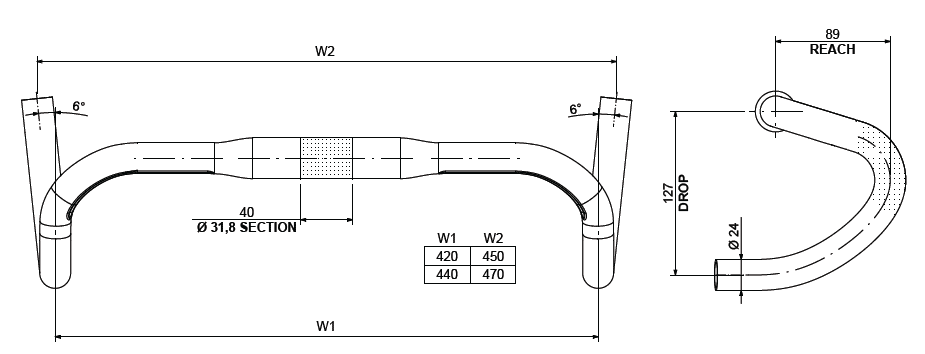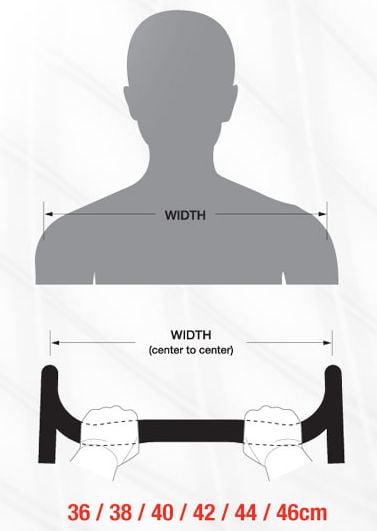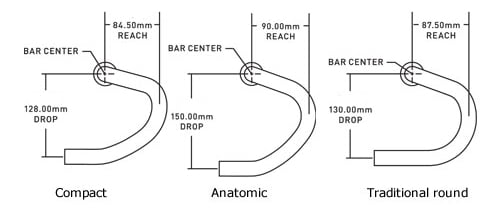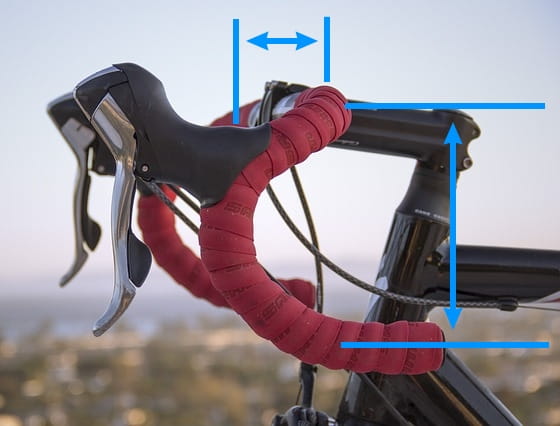This post explains what kinds of road bicycle handlebar shapes exist. The shapes differ in terms of curvature, height difference between the top and bottom part (drops), width etc. The term “drop bar geometry” refers to all that.
Separate posts explain:
- Drop bar hand positions.
- How to adjust road bike handlebars (change height, angle, etc.).
TL/DR
Here, I’ve explained what shapes and models exist, how they differ (the pros and cons of each) – along with the important dimensions (clamp diameter, width, reach, etc.).
The idea is to help you understand what’s what when shopping (especially if you aren’t happy with your current bars).
In my experience, most people who use modern STI levers are comfortable with compact bars, but some prefer the other models (not very often, once you fit them correctly, but it happens).
1. Important bar dimensions
This chapter explains the important dimensions, which are: clamp diameter, hand grip tube diameter, width, reach and drop.

This producer states width both at the top and bottom of bars, since the bottom is made with an outward angle.
The measuring method used is centre to centre of the bar (for width, reach and drop), while the clamp and hand grip diameter are measured as always: the outer diameter.
1.1. Clamp diameter
Handlebar stem clamp diameter needs to be compatible with the stem. There are several standards:
- 25.4 mm (1″) – older standard
- 26 mm – unofficial Italian standard by which many old road bars have been made
- 31.8 mm, or 31.7 mm, depends on how manufacturers round the nominal 1 1/4″ – modern oversized (OS) standard
This, along with hand grip tube diameter, is a measurement that is always taken in a certain way, by outer diameter. The rest of the dimensions are usually measured from centre of the bar to the centre, but sometimes from end to end. Sometimes producers don’t note on the package the measuring method, so in order to make sure, one must measure themselves. 🙂
1.2. Hand grip tube diameter
Diameter of hand grip tube is mostly standard: 23.8 mm.
1.3. Width
It should match riders shoulder width.

The way of choosing the correct bar width.
Standard bar widths are written in red numbers below the image. Below 40 cm is quite narrow, while over 44 cm is considered extremely wide (and not widely available). 🙂
Centre to centre grip tube size should match shoulder width. Like measured in the picture above.
Narrower bars make a bit more aero position, make filtering between cars easier (for those who practice it 🙂 ), but can limit breathing.
Wider bars make for a bit more air drag, with no other ill effects (unless going several sizes wider). The advantage is they provide a better (longer) lever for strong pedalling (sprinting, or uphill riding).
This is a size most often measured in different ways. Sometimes from centre to centre, sometimes the outer width. So before buying make sure what the real size is. Also, have in mind that some bars are wider in the lower part (the drops) compared to the top section.
1.4. Reach

width, reach and drop.
There is also angle of the bar ends, but that will be explained in the shape section.
Reach is the horizontal distance between the stem clamp and the furthest part of the bars. Below 80 mm is considered a short, 85 mm is middle, over 90 is considered a long reach. 70 mm and 100 mm being extreme values.
Too short reach can be compensated with a longer stem, but can leave too little room for hands on the bar tops – on ramps.
Too long reach can of course be compensated with a shorter stem, but can make holding the lower part of the bars uncomfortable – not always the case, but can happen.
1.5. Drop
Drop is the vertical distance between the highest and the lowest part of the bars. It is marked in the picture above (with reach). Drop under 125 mm is considered shallow, 130 mm is middle, while over 135 is a deep drop.
The rule of thumb here is that too shallow can never harm (almost always), while too deep can be a problem – if the rider is positioned lower than comfortable. However, one of the main advantages of road-bike bars is they offer various hand positions, for different ways of riding and for extra comfort by changing one’s sitting position from time to time. Having a small drop can be a step back in those terms (upper body angle when riding in the tops, and in the drops will be less different). Still, if bars can’t be set high enough for comfortable riding in the drops, mounting bars with a smaller drop can help.
2. Bar shapes
There are three shapes: compact, “anatomic” and standard.

2.1. Compact
Short reach and shallow drop. In the era of anatomic brake levers, short reach can often be advantage, since most riders ride holding the tops of brake levers – the hoods. Shallow drop allows comfortable lower grab position (in the drops), while elbows can be bent for even lower, more aero position. Because of shallow drop, this is the most pensioner bar design – good for riders that aren’t very flexible.
It usually has a flat upper part, which makes a comfortable platform, followed by a sharp bend, making brake levers easily reachable when griping bars lower.
2.2. “Anatomic”
Quotation marks are because this is not the most comfortable solution for most. The idea was to make nice straight surfaces for lower grabs, but most people prefer a nice curve, for lots of small hand placement changes. They generally have the deepest drop that suits most riders the least.
2.3. Standard, traditional, “Merckx” round
Longer reach and deeper drop. Not as bad as anatomic bars though. Suits riders that like round upper part of the bars and constant curve radius bar shape. The most sports-like design – good for flexible riders in good shape.
Last updated:
Originally published:

